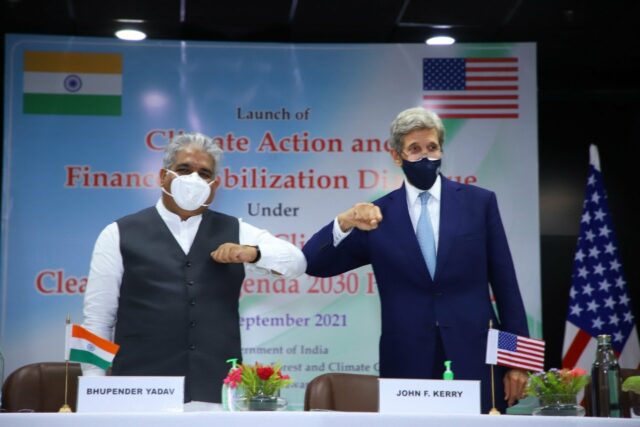NEW DELHI: Ahead of the Glasgow climate summit in late October, US climate czar John Kerry was in Delhi heaping praise on India’s drive for 450 GW of renewable energy by 2030. “PM Modi has set very ambitious targets in India. The target of 450 GW by 2030 of renewable energy, is one of the most powerful goals in the world. You have already reached about 100 GW. I congratulate India for a remarkable milestone,” he said.
But Kerry was seeking to drum up support for Washington’s goal of net zero emissions by 2050. His tweet underscoring Washington’s view that “India’s leadership is essential for our clean energy future. Looking forward to advancing climate discussions this week in New Delhi.”
There was movement on the Climate Action and Finance Mobilization Dialogue (CAMFD) unveiled in April this year. It covers proposals by both sides on curbing emissions, capital and technology to help India scale up its plan for 450 GW of renewable energy and climate adaptation and resilience to help India extend its forest cover.
“CAFMD will provide both countries an opportunity to renew collaborations on climate change while addressing the financing aspects and deliver climate finance primarily as grants and concessional finance, as envisaged under Paris Agreement to strengthen climate action,” Yadav said.
But on net zero, India appears to have stood firm, indicating that climate actions must be “nationally determined.” This message may have been conveyed to Kerry by Bhupendra Yadav, environment minister who as recently as last month had reiterated “that (India) strongly advocates that the differentiation and operationalisation of flexibility provided in the UN Framework Convention on Climate Change and the Paris Agreement for developing countries should be at the core of decision-making.”
Kerry’s visit, the second in five months, underscored another point: that India is at the heart of the “climate battle”. Greenhouse gas emissions by India are the third largest in the world although at 1.84 tons per capita, we are way below the US figures of 16.21 tons per capita (China is at the top). Nevertheless, the US wants India to do more and the reliance on coal is a major concern for them.
Kerry’s last visit had been preceded by that of Alok Sharma, president of COP26 and a key figure in the British cabinet, who had also pushed net zero. “India is on track to overachieve its Nationally Determined Contribution (NDC). I would request if India would consider any NDC that takes into account this overachieving,” he urged. So like it or not, the pressure is on.
Traveller, bibliophile and wordsmith with a yen for international relations. A journalist and budding author of short fiction, life is a daily struggle to uncover the latest breaking story while attempting to be Hemingway in the self-same time. Focussed especially on Europe and West Asia, discussing Brexit, the Iran crisis and all matters related is a passion that endures to this day. Believes firmly that life without the written word is a life best not lived. That’s me, Ashwin Ahmad.





